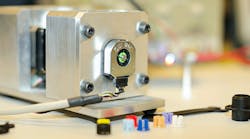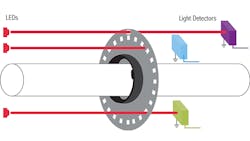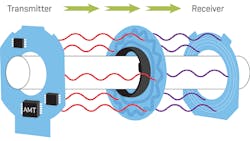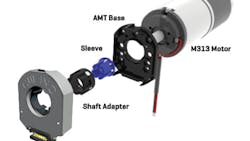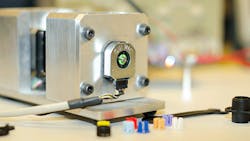Rotary encoders provide critical information about a motor shaft’s position, rotational direction, velocity (rpm), and acceleration. They are vital components in motion-control feedback loops used in industrial, robotic, aerospace, energy, and automation applications. The demand for encoders has been increasing dramatically with the rise in applications requiring precise motion control.
Design engineers are demanding encoders (and other components) that are a good fit for their applications and able to provide long-term reliability, durability, and high performance despite working in severe conditions that include dust, dirt, grease, fluctuating temperatures, and heavy vibrations. Oftentimes, however, engineers must trade off some of these capabilities to meet time or budgeting concerns
Encoder Tradeoffs
Engineers often reflexively want more precision. Standard encoders typically provide between 48 and 2,048 pulses per revolution (ppr), with most applications requiring 800 to 1,024 ppr. Although more ppr rates may seem to offer more precision, they are more costly and more complex, placing additional calculation and processing burdens on the controller or digital processor that is closing the loop. In addition to possibly being unnecessary, too much precision can be a detriment due to noise, vibration, and jitter in shaft position.
One of the more common tradeoffs is between the two most popular type of rotary encoders: optical and magnetic. Optical encoders offer the best accuracy but with reduced reliability. Magnetic encoders, on the other hand, provide better durability but less accuracy. Although some designs avoid using encoders entirely, the reality is that encoders are a vital link in the overwhelming majority of control/feedback loops.
Optical encoders use a glass or plastic disk with two sets of windows around the periphery attached to the shaft. An LED light source and photodetectors mount on opposing sides of the disk. As the disk turns with the shaft, light blinking through the windows hits photocells and their output combines to create the typical square-wave A & B quadrature pulses.
Although widely used, the optical approach has several drawbacks. With respect to ruggedness, factors such as dirt, oil, and other containments--all of which are present during assembly and time in the field--can interfere with the disk, slots, and, thus, the encoder output. The traditional approach to mitigate exposure to contaminants is to place the encoder in a bell housing. Unfortunately, this approach does not completely eliminate exposure to environmental contaminants. Additionally, the housing introduces new factors to the equation including elevated temperatures and higher application costs. For example, if the disk is made of plastic as a cost-reduction measure, it will a have limited temperature range, and any distortions or warping will affect accuracy.
Further, LEDs in optical encoders have limited lifetimes and their brightness can dim by half within 10,000 to 20,000 hr. (roughly one to two years), and eventually they burn out
Magnetic encoders follow the same general principles as optical ones except they use a magnetic field rather than beam of light. Instead of a slotted optical wheel, a magnetic encoder uses a magnetized disk attached to the spinning shaft and it spins over an array of magneto-resistive sensors. Any rotation of the wheel generates responses in these sensors, and they go to a signal-conditioning front-end circuit that determines shaft position and other parameters. Although magnetic encoders are more durable than optical versions, they are not as accurate and are highly susceptible to magnetic interference created by electric motors, most notably stepper motors.
In addition to optical and magnetic encoders, Hall-effect sensors are also used for determining shaft position and other parameters. Although effective and reliable, they are suitable only for relatively low accuracies and resolutions.
Capacitive encoders
To get a rotary encoder that was more durable and accurate, engineers adapted the capacitive-sensing principles of a linear-position encoder developed for push buttons and vernier calipers over 40 years ago. The result is a highly durable and accurate rotary encoder platform.
Capacitive encoders consist of three elements: a high-frequency transmitter, a disk etched with a sinusoidal-metal pattern attached to the shaft, and a receiver board. The rotor mounts between the transmitter and receiver boards. As the rotor turns, its sinusoidal-metal pattern modulates the high-frequency signal in a predictable fashion. The receiver board reads the modulations and a proprietary ASIC translates them into increments of rotary motion at resolutions of up to 4,096 steps/turn.
By design, the encoder ASIC’s electrical output is compatible with optical and magnetic encoders. These non-contact encoders have several user benefits:
• They are not affected by dust, dirt, or oil, and are less sensitive to heat, cold, and vibrations than optical encoders. This makes them more reliable than optical approach devices.
• There are no LEDs to dim or burn out.
• The encoders only need 6 to 10 mA of operating current, far less than the 20 to 50 mA of the optical units. This makes them efficient components for mobile and battery-operated applications.
Because capacitive encoders do not use LEDs or require a clear line of sight between components, they are being used where existing encoders fall short. In one case, the customers of a firm that makes automated baking equipment were having repeated and frequent problems with flour dust and other contaminants affecting the optical encoder on a key production unit. Fixing it required monthly shutdowns and re-zeroing the encoder. After replacing the optical unit with a capacitive one, the problems disappeared.
In another case, a manufacturer of off-shore drilling equipment needed to submerge an entire motor in oil due to high pressures associated with the application. They opted to use a capacitive encoder because it could operate without interruption in nonconductive fluids such as oil.
There is another benefit, although a less obvious one, for those who fine-tune proportional-integral-derivative (PID) control loops: the ability to adjust the encoder’s ppr count to get the best performance without changing encoders. This ability to dynamically modify the resolution simplifies system optimization, which is usually done by adjusting the code or changing the encoder’s line count (resolution). With optical encoders, this latter process requires different encoders be purchased and installed, increasing overall cost and lengthening design cycles. With capacitive-based encoders, control engineers simply change the encoder’s line count parameter of the encoder until they get the control-loop result they want.
Capacitive encoders also bring benefits in installation and production. Mechanically, their mounting holes are matched to those of other types of encoder, making them a fit-and-function compatible unit and a drop-in replacement. Thus, a single encoder can be fitted to different diameter shafts simply by using adapter sleeves, which reduces the number of stock-keeping units in production and repair inventory.
One possible concern with capacitive-based encoders is that they are susceptible to electrical noise and interference, just like any electronic transducer and its associated circuitry. Careful design of the ASIC interface circuitry, as well as fine-tuning the encoder demodulation algorithms, can mitigate this issue. The ASIC also offers opportunities for designs to include embedded, on-board diagnostics to verify the ASIC and encoder’s performance as part of a more intelligent encoder and subsystem.
With the availability of the field-tested encoders based on capacitive-sensing principles, there’s no longer a need for the design engineer to make the difficult choice between optical and magnetic encoders. Capacitive encoders excel at reliability and output accuracy, and also bring benefits in mounting, inventory, ppr selection, readout zeroing, and power consumption, all while being fully compatible with standard outputs.
What About Sensorless Designs?
Sensorless designs in which motors don’t use encoders are becoming more popular. They use motors controlled by a variety of algorithms including field-oriented control (FOC), which is also called vector control.
Although eliminating encoders is certainly attractive in theory, FOC has several drawbacks: it is not as precise as a sensor-based design; it can lose position and require resets; there are control issues at points in the torque range; and it requires considerable computational effort by the system processor. As a result, FOC is mostly used when high precision and consistency in shaft position and speed are not critical, such as consumer appliances (washers and dryers). For most industrial products, though, the cost of the encoder is more than worthwhile to achieve performance requirements.
